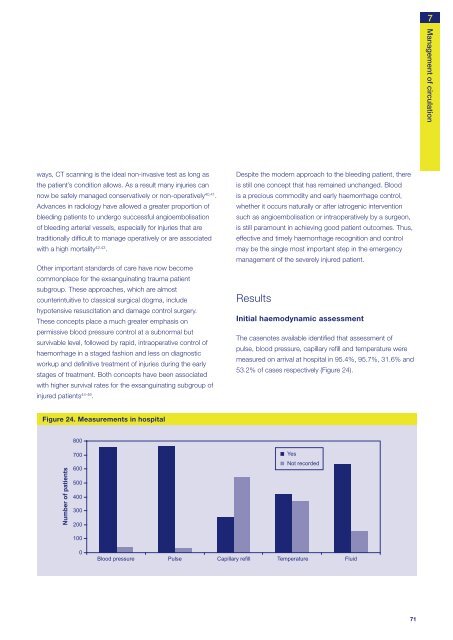CHAPTER 7 - Management of circulationIntroductionThe importance of haemorrhage control after injury is crucial.Best published evidence suggests that 30-40% of earlytrauma deaths are directly attributable to haemorrhage 1,2 .The American College of Surgeons Committee on <strong>Trauma</strong>Multiple Outcome Study has estimated that 62% of allin-hospital trauma deaths occur within the fi rst four hours,of which haemorrhage is either the primary cause or amajor contributing factor 3 . Not only does haemorrhagecontribute directly to early mortality, but blood loss leadingto hypotension is a major factor in the development ofsecondary brain injury 4,5 as well as contributing signifi cantlyto late trauma deaths from multi-organ failure 6,7 .Shock is a condition of inadequate end-organ perfusion.In the severely injured patient, shock may be multifactorial,but haemorrhage is the leading aetiology. In the shockedpolytrauma patient, the physiologic and metabolic reservecan quickly become exhausted, leading to decompensationand a deadly triad of hypothermia, coagulopathy andacidosis, all of which are independent prognostic indicatorsof outcome 8-13 . Treatment of these patients is aimed atpreventing or reversing this metabolic derangement byrecognising fi rstly that haemorrhage exists (preferentiallybefore decompensation), followed by timely intervention toarrest the bleeding and restore circulating volume, and henceoxygenation, to the tissues. Such timely management isassociated with improved patient outcomes 14,15 .The management of haemorrhage should begin in theprehospital fi eld and continue right through the hospitalsystem in a continuous process of assessment, treatmentand reassessment in a timely, co-ordinated fashion. Modern,dedicated trauma systems and major trauma centreshave developed out of a need for rapid transportation,assessment and treatment of the bleeding patient. Suchdedicated shock-trauma systems are associated with shorterprehospital times 16-18 , shorter throughput times to defi nitivecare at an appropriate facility 19,20 and better outcomes forthe severely injured patient 16, 21-24 . Nevertheless, the majorityof preventable deaths after injury occur from unrecognisedand hence untreated haemorrhage, particularly within theabdominal cavity 25-28 making it perhaps the single mostimportant reversible cause of death in the trauma population.Defi ning the point at which a patient becomes ‘shocked’ isdiffi cult as bleeding patients are often in a state of dynamicphysiologic fl ux. However, recognition of ongoing bleedingis the fi rst step in management. The Advanced <strong>Trauma</strong>Life Support (ATLS) course has become a well-recognisedand accepted paradigm in the initial management of thebleeding patient. Although the optimum end points foreffective resuscitation are less clear clinically 29,30 , currentpractice in the acute assessment of the injured patient isbased on a dictum of readily available and measurableparameters such as blood pressure, pulse rate, respiratoryrate, capillary refi ll, oxygen saturations and GlasgowComa Score. This has formed the basis for the format ofquestions in the management of circulation after injury forthis <strong>NCEPOD</strong> study. These are simple bedside assessmentswhich may be repeated, and aim to recognise the bleedingpatient early. In the physiologically normal, stable patientwho has not decompensated, time allows for more detaileddiagnostic workup for occult bleeding and organ injury.Simple, rapidly performed tests should also be performedearly in management that may refl ect both regional andglobal hypoperfusion including; pH, lactate, base defi cit andbicarbonate levels 31-36 .The modern approach to the management of haemorrhageafter injury has evolved greatly in the two decades with theadvent of better evidence based practice. Older diagnostictests, such as diagnostic peritoneal lavage (DPL) have nowbeen largely superseded by other imaging techniques suchas bedside ultrasound (focussed abdominal sonography fortrauma (FAST)) 37-39 and more judicious use of CT scanningfor the physiological normal and stable patient. In many70
7Management of circulationways, CT scanning is the ideal non-invasive test as long asthe patient’s condition allows. As a result many injuries cannow be safely managed conservatively or non-operatively 40,41 .Advances in radiology have allowed a greater proportion ofbleeding patients to undergo successful angioembolisationof bleeding arterial vessels, especially for injuries that aretraditionally diffi cult to manage operatively or are associatedwith a high mortality 42,43 .Other important standards of care have now becomecommonplace for the exsanguinating trauma patientsubgroup. These approaches, which are almostcounterintuitive to classical surgical dogma, includehypotensive resuscitation and damage control surgery.These concepts place a much greater emphasis onpermissive blood pressure control at a subnormal butsurvivable level, followed by rapid, intraoperative control ofhaemorrhage in a staged fashion and less on diagnosticworkup and defi nitive treatment of injuries during the earlystages of treatment. Both concepts have been associatedwith higher survival rates for the exsanguinating subgroup ofinjured patients 44-46 .Despite the modern approach to the bleeding patient, thereis still one concept that has remained unchanged. Bloodis a precious commodity and early haemorrhage control,whether it occurs naturally or after iatrogenic interventionsuch as angioembolisation or intraoperatively by a surgeon,is still paramount in achieving good patient outcomes. Thus,effective and timely haemorrhage recognition and controlmay be the single most important step in the emergencymanagement of the severely injured patient.ResultsInitial haemodynamic assessmentThe casenotes available identifi ed that assessment ofpulse, blood pressure, capillary refi ll and temperature weremeasured on arrival at hospital in 95.4%, 95.7%, 31.6% and53.2% of cases respectively (Figure 24).Figure 24. Measurements in hospital800Number of patients7006005004003002001000Blood pressure Pulse Capillary refill Temperature FluidYesNot recorded71
















